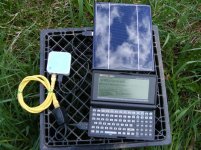I thought I'd share my experience getting an HP palmtop online in 2013:
I have an HP 1000CX, which is nearly identical in hardware to the classic 200LX organizer, but missing any PIM software. It's basically an XT-compatible computer running MS-DOS 5 that runs off two AA batteries.
(anything I explain in this post can be applied to the 100/200LX with very little modification)
The HP palmtop has a PCMCIA 2 slot that can power any 5V card with maximum 150mA of power. Unfortunately, this means most modern network cards won't work. The search is further limited to cards with a compatible DOS packet driver.
Luckily, I've found one card that fits the requirements (with some software tweaking). The Sohoware ND5120 is a 10Mbps 16-bit LAN card with the universally supported NE2000 chipset. There seems to be a few on eBay at any given time.
You'll need the following software to get it working:
"LxCic (V2.1, 17K, 22-OCT-99) is a I/O card enabler and thus a CIC100 alternative on the Palmtop. LxCic may be used nonresident or resident. If loaded resident, it only takes 1200 bytes of memory and may be unloaded at any time. Currently supports modem and network cards. Source code included." -http://hplx.pgdn.de/
"LXETH (The HP200LX Ethernet Packet Driver) is an open-source freeware packet driver for ethernet cards that are compatible with the HP200LX palmtop." -http://lxeth.hplx.net/
KILLMSG: Whenever the palmtop is brought out of standby or rebooted, the Sohoware card draws a little bit too much power for the system's liking and you get an annoying low battery warning. KILLMSG.COM disables this.
Here's what I put in the AUTOEXEC.BAT. REM the CIC100 line as it's being replaced with LXCIC:
From here, you can install and configure mTCP or whatever other stuff that can fit on the tiny drive. My palmtop has a 2MB RAM disk, of which 640KB is allocated to conventional memory, leaving about a floppy diskette's worth of space on the C: drive.
The HP 100LX/200LX/1000CX has an 80186 CPU running at about 8MHz, so networking options are somewhat limited. I chose to cheat a little and simply telnet into a router running OpenWRT as a wireless client and SSH from that into a remote system to do things like email and web browsing. Honestly, a serial connection into the router would do the exact same thing and use way less power, but it was fun tracking down the old info and parts to make this convoluted, roundabout setup work!

I have an HP 1000CX, which is nearly identical in hardware to the classic 200LX organizer, but missing any PIM software. It's basically an XT-compatible computer running MS-DOS 5 that runs off two AA batteries.
(anything I explain in this post can be applied to the 100/200LX with very little modification)
The HP palmtop has a PCMCIA 2 slot that can power any 5V card with maximum 150mA of power. Unfortunately, this means most modern network cards won't work. The search is further limited to cards with a compatible DOS packet driver.
Luckily, I've found one card that fits the requirements (with some software tweaking). The Sohoware ND5120 is a 10Mbps 16-bit LAN card with the universally supported NE2000 chipset. There seems to be a few on eBay at any given time.
You'll need the following software to get it working:
"LxCic (V2.1, 17K, 22-OCT-99) is a I/O card enabler and thus a CIC100 alternative on the Palmtop. LxCic may be used nonresident or resident. If loaded resident, it only takes 1200 bytes of memory and may be unloaded at any time. Currently supports modem and network cards. Source code included." -http://hplx.pgdn.de/
"LXETH (The HP200LX Ethernet Packet Driver) is an open-source freeware packet driver for ethernet cards that are compatible with the HP200LX palmtop." -http://lxeth.hplx.net/
KILLMSG: Whenever the palmtop is brought out of standby or rebooted, the Sohoware card draws a little bit too much power for the system's liking and you get an annoying low battery warning. KILLMSG.COM disables this.
Here's what I put in the AUTOEXEC.BAT. REM the CIC100 line as it's being replaced with LXCIC:
Code:
KILLMSG.COM /M /C
LXCIC.COM /L
LXEN2216.COM 0x66From here, you can install and configure mTCP or whatever other stuff that can fit on the tiny drive. My palmtop has a 2MB RAM disk, of which 640KB is allocated to conventional memory, leaving about a floppy diskette's worth of space on the C: drive.
The HP 100LX/200LX/1000CX has an 80186 CPU running at about 8MHz, so networking options are somewhat limited. I chose to cheat a little and simply telnet into a router running OpenWRT as a wireless client and SSH from that into a remote system to do things like email and web browsing. Honestly, a serial connection into the router would do the exact same thing and use way less power, but it was fun tracking down the old info and parts to make this convoluted, roundabout setup work!

